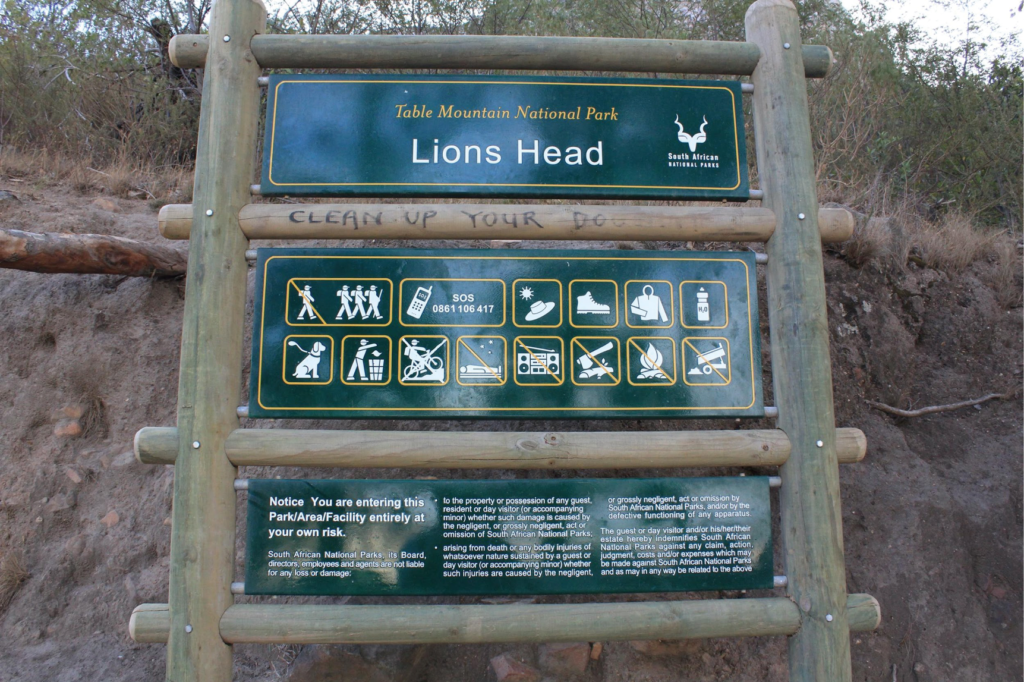Travel report on my hike up Lion's Head

Lion's Head ist a cone shaped mountain right between Table Mountain and Signal Hill in Cape Town, South Africa. I cannot recall now how often I pulled myself up its mane. Five or six times? And with mane I mean the iron chains and steps which you have to climb during a short but somewhat difficult passage.

You find it around mid ascent is really not the typical for regular hikers. It is only a short passage but demands some bravery and a bit more physical fitness. Or a detour to get around it. Luckily that detour exists.
You can explore the whole hike–also the detour without the climbing section–virtually in my virtual 360° panoramic tour of Lion's Head.

The detour makes the day trip only a little bit longer. Yet, also here counts: those who suffer from extreme fear of heights should not walk up Lion's Head.

Immer wieder gibt es Passagen mit sehr engen Wegabschnitten, die sich klippenartig direkt an sehr tiefen Abgründen entlangschlängeln, nur gelegentlich mit Halteketten versehen.

I strongly recommend the detour for your descent. Especially when you visit Lion's Head for the moonrise you will experience longer waits at the climbing parts. I once had to wait extremely long because some teacher brought his small and totally unprepared school children there fearfully laywaying down the rocks in the pale light of the moon.
Well, the moonrise during full moon is probably worth even that. But first things first: start your hike early afternoon to make sure you have nice place to picnic. On full moon it gets very crowded up there. This also means to take enough water with you, approx. 2 liters per person! From November to March also the night temperatures can be above 30° Celsius in Cape Town.
For the hike you should use light hiking boots. Especially at the climbing passages softer soles might offer better grip and feel. A hat and sunscreen are a must. (At the end of this article you'll find a list with recommended equipment for the hike up Lion's Head.)

Upon arrival you'll find many flatter places to rest, picnic, and to enjoy the view. Concerning the view you have to find your individual compromise: closer direction Table Mountain with a view on the Twelve Apostles that shine golden in the light of the setting sun, or more direction Signal Hill with a wide view both on the ocean and Cape Town. Or you first choose a place on the ocean side for the best view on the sunset – and change afterwards to the city side to enjoy the best view on the moon that will rise behind the sea of Cape Town's sparkling city lights.

On the top it is mostly very windy. It is advisable to take some warmer clothes with you, like long trousers like a pair of jeans, a sweatshirt or a light fleece jacket and a light scarf. Actually, longer trousers also make sense for the climbing passage to save your skin.
It is very important to bring a headlamp for the descent. The light of the full moon can be enough for some. But when everyone else on the trail uses lamps, your eyes are constantly thrown out of dark mode. And keeping a distance from other hikers is often very difficult due to the large number of hikers here.

At the start of the trail several benches with backrest invite you to take a rest. But be aware: you will find amazing views all along the way. In later passages sometimes flat stones offer good resting possibilities, and depending on the altitude of the sun even in the shade of Lion's Head.

Dangerous parts:
I already mentioned the climbing passage above. The waypoints that don't seem dangerous at first could be even more so: roots and stair fixations made of wood that have become very slippery over the years. Also the 2 meters high iron ladders you have to climb here and there on the trail are very slippery, especially when they are wet from the sweat of people that walk right in front of you. No sole can give you perfect grip there. In combination with the trail's dust you should always test your grip during the respective sections. And even if some Capetonians run up Lion's Head with their running shoes, I clearly recommend hiking boots that cover your ankles. The trail is not that long and help not too far away. But once you strained your ankle, your day trip can quickly turn into a bad trip.



Getting there:
According to friendsoflionshead.org the public MyCiTi buses 106 and 107 take you to the bus stop "Kloof Nek 2" respectively "Kloof Nek 1". However, most people take the car. Coming from Cape Town heading towards Camps Bay you take the road "Kloof Nek". Take turn off at the sign directing you to "Signal Hill" (you also find the bus stop here) – and then go on until you reach the Lion's Head parking lot. During the time of full moon you should arrive early because the parking space is limited. Normally there are car guards, however, no item should be left visible in the car but rather stowed in the trunk. In general, a car guard should always be given a tip upfront, officially or not and also if he already left before you return to your car.
Activities:
Lion's Head offers a runway for paragliding (flex-wing). Hey, but hiking is so much better, isn't it.


Important:
What you bring should be taken with you again. This counts for any kind of garbage like wrappings, bottles, fruit skins or egg-shells and most importantly cigarette butts! Due to draughts the danger of causing forest fires in South Africa is extremely high.

Recommendations for your preparation:
For the hike:
Short hiking trousers
Light long hiking trousers
Light hiking boots that support your ankles
2 liters of water per person
Headlight
Hat
Sunscreen
Sunglasses
Patience at the climbing passages
For the top:
T-shirt to change
Long sleeve shirt / sweatshirt / light fleece jacket
Food & beverages for a picnic
Picnic blanket
Camera
Links:
Table Mountain National Park – South Africa's official national park website: Sanparks
Bus connections: MyCiti
Good to know: Friends of Lion’s Head
Weather conditions in Cape Town: via Google
Moon phases / moonrise: via Google
Local news: Cape Times
Explore the whole hike now virtually–also the detour without the climbing section–in my virtual 360° panoramic tour of Lion's Head.
*The links that are marked with an asterisk are affiliate links. The help to finance this site's production by advertisements. (After every link you'll find the respective brand to which the link leads you to.) With every click you help that this hiking website can stay alive and regularly offers new virtual panoramic tours of popular hiking trails. The same counts for the advertising banners, which are chosen as relevantly as possible for hikers and travelers.

